2023 Convenience Store Trends: Food, Fuel, and the Future
Consumers don’t care about the traditional divisions between industries. Channel blurring, the purchasing of goods and services from an alternative...
4 min read
Sarah Beckett June 11, 2024

Our Convenience Store Trends Report 2024 - Powering the Next Era of Convenience Store is finally here! This year, we aimed to address three primary questions:
Editor's Note: This blog now features fresh insights from our 2024 C-Store Trends Report! Curious about last year's trends? You’ll find the key takeaways from the 2023 report at the end of the post.
To answer these questions, we analyzed data collected through consumer perception surveys as well as mystery shops and operational audits performed across the US.
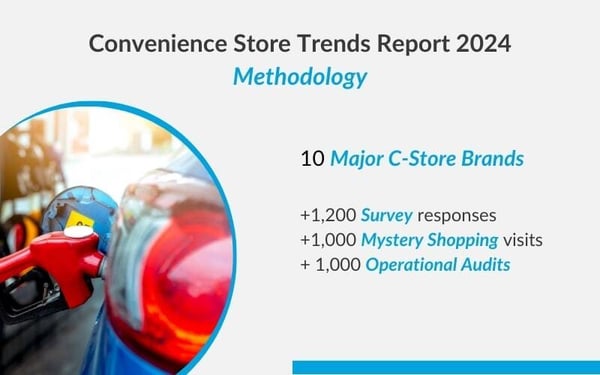
This strategic approach has provided insights into the current landscape and emerging convenience store trends, guiding store operators on how to adapt and thrive in this evolving industry effectively.
The convenience store market is anticipated to grow annually by 5.6% until 2028. Are you ready to be part of this growth?
Download the Convenience Store Trends Report 2024 by clicking below, or keep reading to discover the key takeaways.
Gasoline, not surprisingly, remains the predominant purchase at convenience stores, accounting for 62% of their overall sales.

However, the automotive fuel landscape is rapidly evolving, and C-store brands must adapt to capitalize on emerging opportunities.
The global market for electric vehicles (EVs) has seen explosive growth, with over 40 million EVs now registered worldwide—a more than sixfold increase since 2018. This shift towards alternate fuels presents both a challenge and an opportunity for C-stores.
As more consumers drive EVs, the convenience of having charging facilities will become a significant factor in their choice of retail locations. This can increase foot traffic and lead to additional sales in-store while customers wait for their vehicles to charge.
Curious to learn how EV charging stations are transforming Convenience Stores?
As convenience store brands look to the future, new revenue streams are being explored, tested, and rolled out.
One significant trend reshaping the industry is the growth in food options. No longer limited to roller grill hotdogs and stale coffee, C-stores now offer restaurant-quality food, attracting a wider and more diverse customer base.
More than half of the consumers surveyed in our study believe that the made-to-order food available at C-stores provides good value for their money.
This positive perception highlights the shift towards higher quality, fresh, and customizable food options, which are becoming a staple in many C-store brands.
Another particularly successful strategy for attracting more customers in-store has been enhancing coffee offerings. Selling high-quality, specialty coffee can make C-stores a go-to destination for coffee lovers and boost foot traffic and customer loyalty.
Want to know how food and coffee choices can shape customers' experiences at C-stores?
Retail Media Networks (RMNs) are a rising convenience store trend. It is also a potential new revenue source for petro-convenience chains that we have recently begun tracking.
According to Convenience Store News, RMNs are expected to generate a predicted $89 billion in revenue by 2026 through the sales of ad space to third-party brands.
Traditionally, RMNs have been focused on digital advertising. Still, in-store RMNs have grown in popularity among C-store brands, with some chains, like Wawa, Casey’s General Stores, and 7-Eleven, launching branded platforms, highlighting the potential of this revenue stream.
With significant daily foot traffic, C-stores are ideal for in-store advertising. RMNs enable convenience stores to monetize this traffic by selling ad space to brands that want to reach a similar audience.
When asked whether digital advertising displayed at a convenience store would impact the shopping experience, 35% of consumers said they had purchased an advertised product.
Download the latest Convenience Store Trends Report 2024 to discover how retail media is transforming the shopping experience.
We have seen the shift towards contactless experiences across various industries, including petro-convenience.
Customers are increasingly seeking control over their shopping experiences, which is driving the adoption of self-checkout and curbside pickup for online shopping.
Data shows that in 2022, two-thirds of millennial consumers in the United States chose curbside pickup when shopping online, highlighting the significant role of the younger demographic in shaping this trend.
46% of North American customers prefer self-checkout for its speed, employee interaction avoidance, and the ability to pack their own bags.
Bringing new streams of income and standing out from the competitors is essential.
Still, operators also have to find a way not just to attract new customers but turn them into loyal brand advocates who will come back.
Mobile apps, which represent convenience and speed, offer a powerful tool for achieving this goal, creating a personalized connection with customers and offering opportunities to drive engagement, loyalty, and sales.
As the demand for ready-to-eat options at convenience stores rises, maintaining a spotless environment has also become essential.
The focus on cleanliness not only attracts customers but is also one of the top factors when it comes to choosing a convenience store over another.
By prioritizing cleanliness and store appearance, brands can create a more enjoyable shopping experience, encouraging longer visits and increasing the likelihood of repeat business.
Ready to dive into the full report?
Our Convenience Store Trends Report 2023 - Food, Fuel, and the Future analyzed how technology is impacting the competition between convenience stores and quick-serve restaurants (QSR) industries.
Consumers don’t care about traditional divisions between industries. Channel blurring, the purchasing of goods and services from an alternative provider instead of one traditionally associated with it, is commonplace today. This is especially evident in the competition between convenience stores and quick-serve restaurants.
For years, convenience store brands have been investing heavily in their prepared and made-to-order food options. But are they doing enough to win the battle for share of the stomach against the well-established quick-serve players?
As restaurants invest in electric vehicle charging stations, will they draw consumers away from convenience stores?
Consumers are primarily turning to convenience stores for food on the go. In fact, 77% reported eating the meal they purchased in their car.
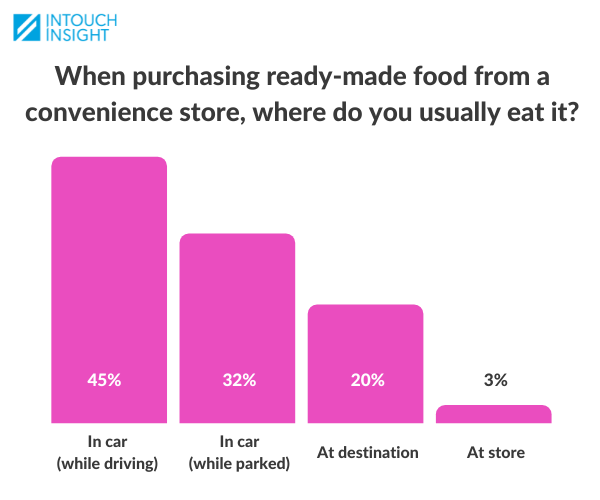
Quick-serve restaurants have been investing heavily in customer-facing technology in order to attract customers in a hurry. For example, Taco Bell’s Defy location in Minnesota features a 4-lane drive-thru and vertical lifts to deliver customers’ orders.
Meanwhile, convenience stores have not yet widely adopted customer-facing technology. This summer, Intouch Insight conducted audits of nearly 800 convenience store locations across the United States. Of the brands we visited, half only offered self-checkouts, and 30% of their locations or less.
Read the full Convenience Store Trends Report 2023 here.
So far, convenience stores have roughly kept pace with the popularity of electric vehicles (EVs). As part of our annual audits of convenience stores, Intouch Insight has been tracking how many locations feature EV charging stations. While we found fewer compared to last year, 12% of the locations we visited in 2023 feature charging stations.
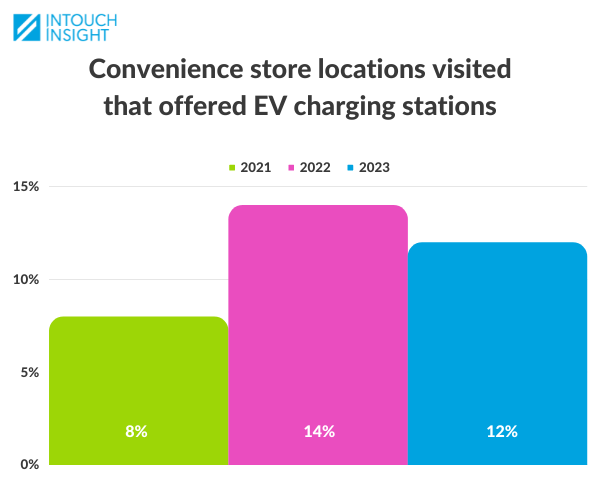
The International Energy Agency estimates EVs will account for 18% of the car market in 2023. However, S&P Global Mobility predicts EVs could account for up to 40% of new vehicles by 2030. This leaves a lot of ground to make up in a short amount of time.
This presents another area for competition between convenience stores and quick-serve restaurants. Taco Bell began installing charging stations at select locations in 2022, and Subway announced its intention to do so in 2023.
Read the full Convenience Store Trends Report 2023 here.
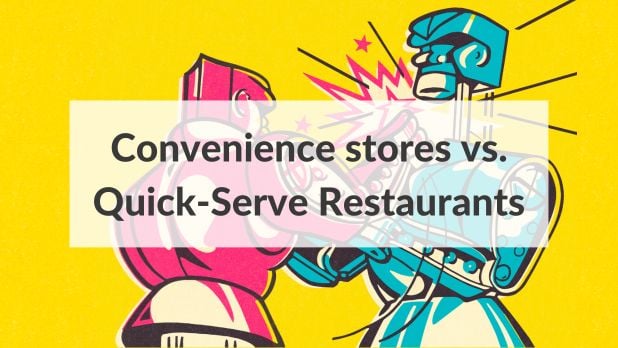
Consumers don’t care about the traditional divisions between industries. Channel blurring, the purchasing of goods and services from an alternative...
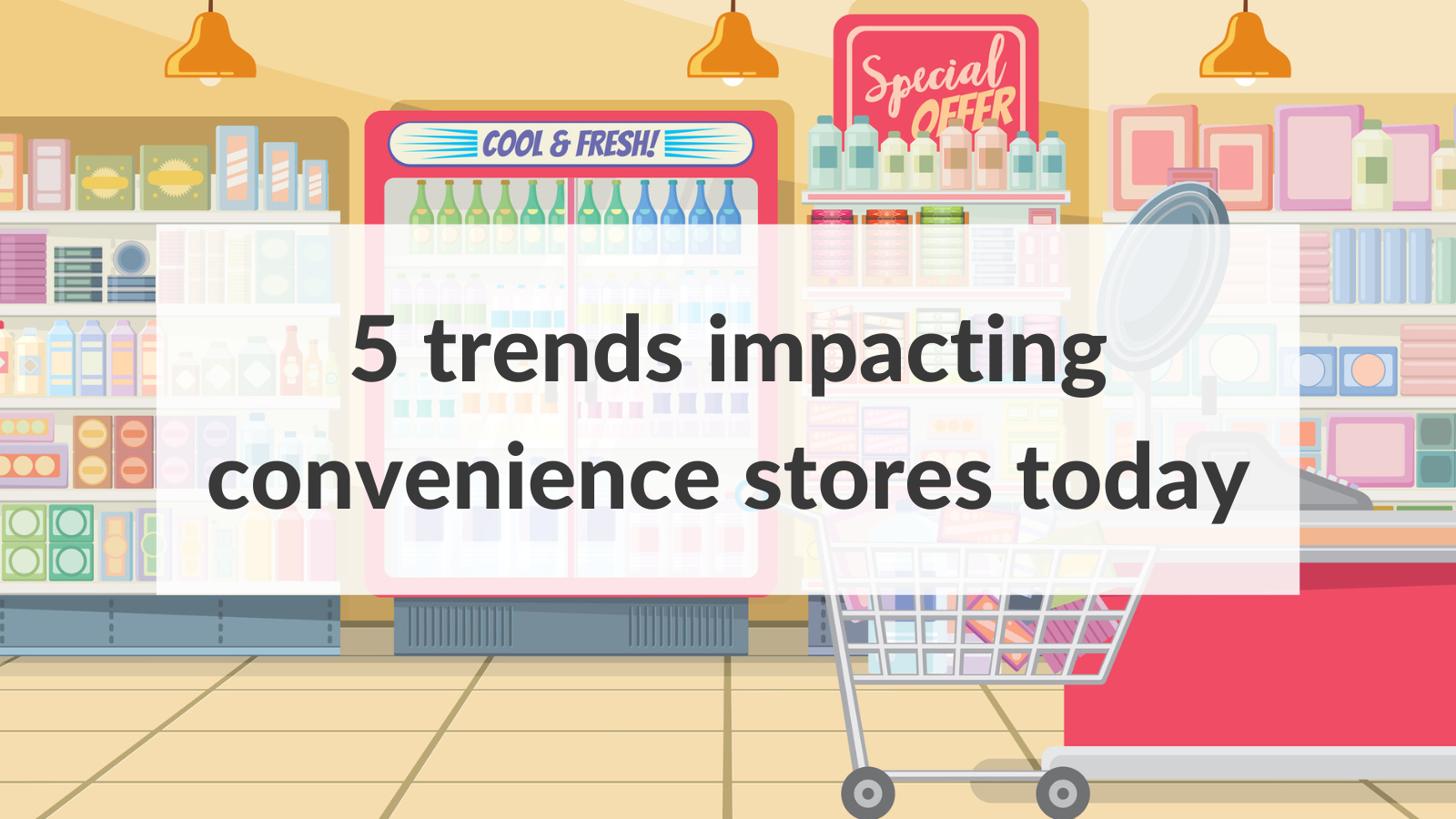
With compounding external factors such as supply chain issues, labor shortages, and rising inflation impacting the daily operations of convenience...

This month we've looked at COVID-19’s impact on the Retail and Restaurant industries. Now, as we round out June, we're diving into how changes in...